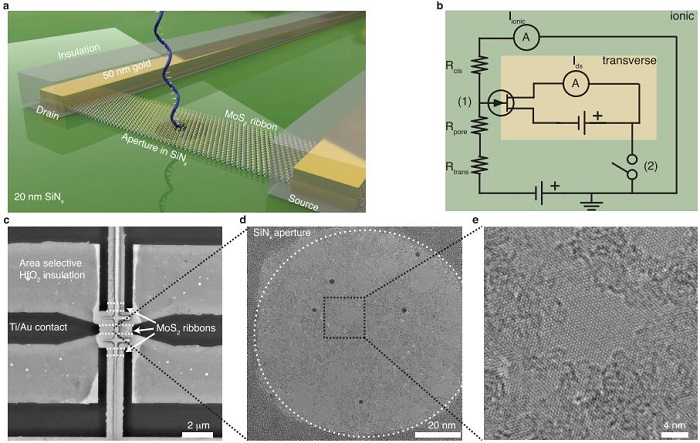This website uses cookies to ensure a better user experience.
To get more information, please read our Cookie Statement.
Transverse Detection of DNA Using a MoS2 Nanopore
Our colleague Damir Altus, together with M. Lihter and S. Marion, Institute’s alumni currently working in the group of prof. A. Rađenović at École Polytechnique Fédérale de Lausanne, published a paper in prestigious journal Nano Letters describing DNA detection technique using molybdenum disulfide nanoribbon integrated with a nanopore. DNA molecules are sensed by correlated signals from the ionic current through the nanopore and the transverse current through the nanoribbon using field-effect transistor configuration.
Transverse detection of DNA using a MoS2 nanopore
Michael Graf, Martina Lihter, Damir Altus, Sanjin Marion, Aleksandra Radenovic, Nano Letters XX, XXX-XYY (2019).
DOI: 10.1021/acs.nanolett.9b04180
Advanced concept of DNA sequencing, i.e. detecting molecular translocation, using nanopores of ultrathin solid state materials-atomic thin layers-lays a cornerstone on which major technological advances related with improvement of healthcare is based. Key concept in electrophoretic DNA translocation is based on sensing modulations in ionic current passing through a nanopore that is varied in the process of translocation of basis of different size. Whenever a molecule electrophoretically translocates through the narrow constriction, it modulates the ion current. Challenges in development of new nanopore sensing technology are related to limitations in spatial resolution and maximum readout speed.
Research published in this publication provides important contribution in this field, as the authors used atomically thin MoS2 in the form of free standing 500 nm wide nanoribbon. This nanoribbon is active channel in the field-effect transistor sensing scheme with 1-2 nm sized nanopores. The authors used and optimized correlated measurements of ionic and transverse current through the transistor, which demanded for development of advanced electronic circuit based of differential amplifier that separates and mutually isolates ionic and transverse circuits. Furthermore, it was observed that this correlation is dependent on the charge of the molecule that is translocated.

Figure: Device overview. (a) A schematic of the proposed FET-nanopore device. (b) The equivalent electrical circuit describing the two subcircuits, denoted here as ionic and transverse. (c-e) Varios TEM images of a finished device at different magnification.
Correlated signal that was observed in transverse circuit is predominantly related to the charge field of a molecule that is being translocated. Although this study shows evidence of certain drawbacks, such as the problem of instability of freestanding MoS2 nanoribbons in correlated measurements, or necessity for additional controlled field effect in such nanofluidic circuit, results of correlated measurements are promising tool for future development of translocation technology through the atomically thin nanopores and for fundamental understanding of the translocation process.




